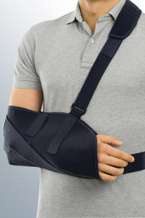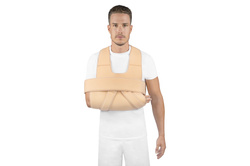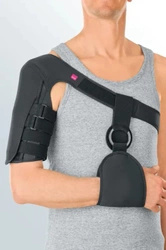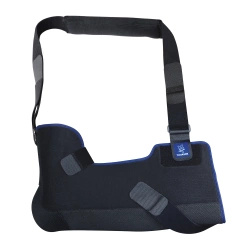Shoulder braces & Arm support
( number of products: 59 )Shoulder braces for pain relief and support
Shoulder injuries, such as ruptured joint capsules, rotator cuff injuries and Bankart lesions can cause excruciating pain for sufferers. However, these conditions can be completely treated with the help of a well-chosen shoulder support. Read on and find out more!
Shoulder braces - who are they for?
A shoulder support, such as the abduction and rotating postoperative brace are essential in the treatment of a ruptured joint capsule and the healing process of a shoulder arthroscopy. However, such braces are also important in treating rotator cuff and dorsal muscle injuries, Bankart lesions and other conditions. In such cases, a shoulder support is meant to help heal damaged tissues and sutures without disturbing them process, as doing so could negatively impact the effects after surgery.
The shoulder brace can also be used in the case of joint dislocations, sprains and shoulder instability, as well as inflammation of the acetabulum and joint capsule. Shoulder supports are functional and comfortable medical products that encourage patients to remain active after surgery.
These supports may also be used for treating subacromial impingement syndrome. This is one of the standard methods for treating recurring inflammation and chronic or acute pain in the shoulders and arms. In this situation, the shoulder brace is designed to relieve the limb and reduce pressure that causes shoulder pain. This method is most often used before rehabilitation and surgery.
How does the shoulder brace work?
Shoulder braces guarantee proper joint stabilization which reduce shoulder pain and begin the road to recovery. The angle adjustment option will stabilize the shoulder to ensure that your arm is in the correct position. The angle can be changed as the therapy progresses, however, it is vital that you consult a doctor or physiotherapist for medical advice.
In some cases, the brace can be used to completely immobilize the arm, which is especially important after surgery. In this situation, it prevents movement that would damage the sutures and keeps the arm and the shoulder immobile until the rehabilitative process begins. By restricting the range of motion, excessive pain can be prevented, as well as postoperative swelling.
The types of shoulder braces
Braces, such as the upper limb brace, which work as a postoperative and injury-treating product are equipped with angle adjustment and telescopic length adjustment options for the arm and forearm. Some of these supports even offer hand protection against pain caused by pronation and supination, which may occur during the rehabilitation period. A shoulder joint stabilizer can also come equipped with a regulator that allows you to control the range of motion at every stage of therapy.
When choosing a shoulder stabilizer, look for an option that is easy to put on and take off, as you don’t want to cause more shoulder injuries when doing so. This is important, especially if you want to put it on and take it off yourself. Putting on a shoulder brace and fitting it accordingly should be easy to do and usually requires no outside help.
Each shoulder brace is made of high-quality materials that guarantee shoulder and arm stabilization. Thanks to product’s durable skeleton, the shoulder remains in place and the quality lining does not cause irritation or rashes.
There are a number of shoulder braces, all of which offer complete stiffening, as well as abduction with the help of a rail, airbag, or other options. When choosing a brace that will guarantee you the best rehabilitation results, consult with a doctor or physiotherapist and ask for their medical advice. Our store offers high-quality orthopedic products in a variety of sizes, from the most reputable brands. We provide a wide selection and secure shipping.

Brace for shoulder immobilization Shouldfix light Orthoservice

Comfort Figure-Of-Eight Shoulder & Clavicle Support E-250 Orliman

Elbow brace with ROM Elbo 2.0 with neutral hand support system Orthoservice

Omo Immobil Rotation 50A11Otto Bock Post-Op Shoulder Support
















